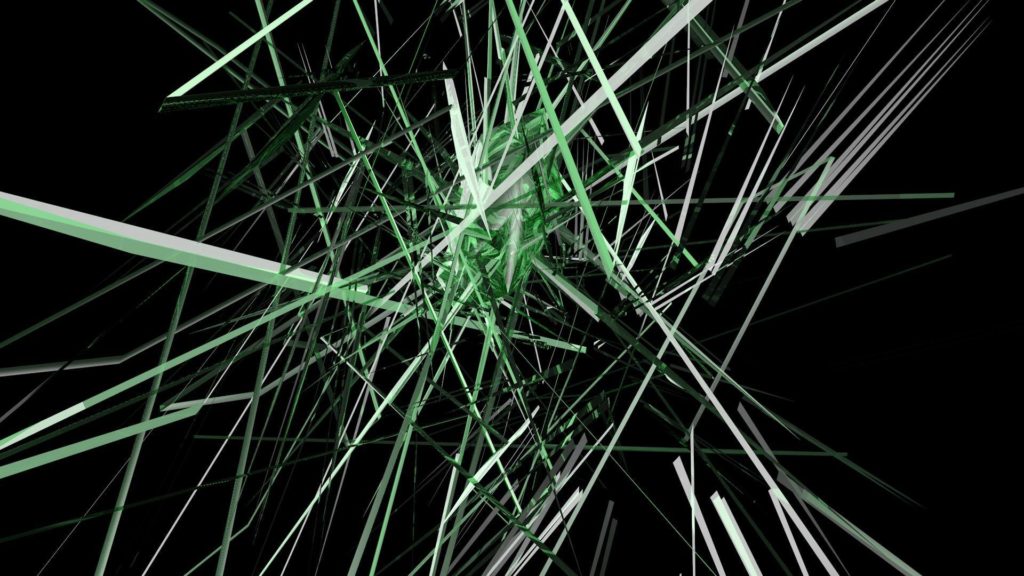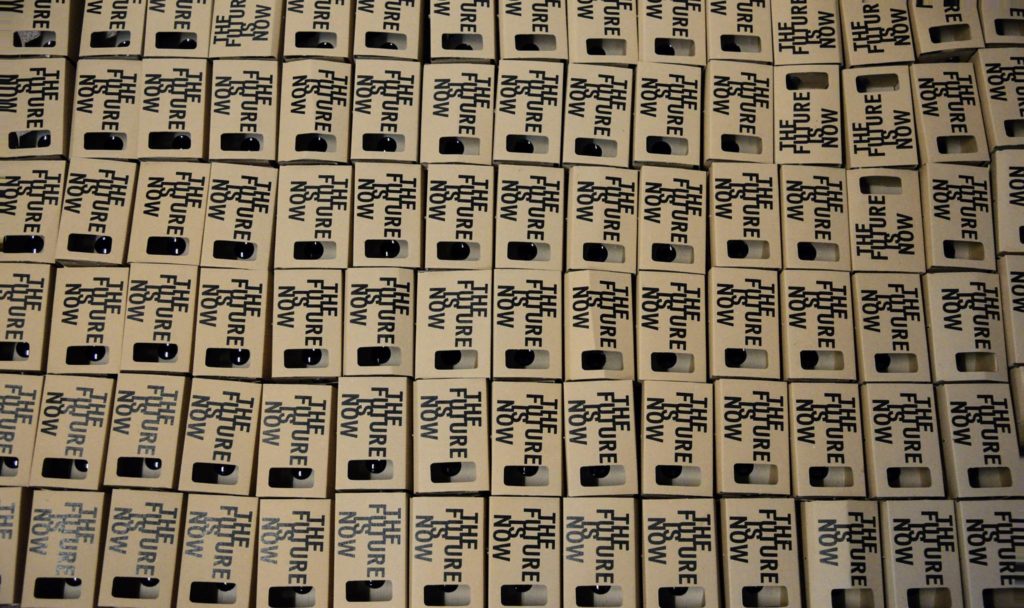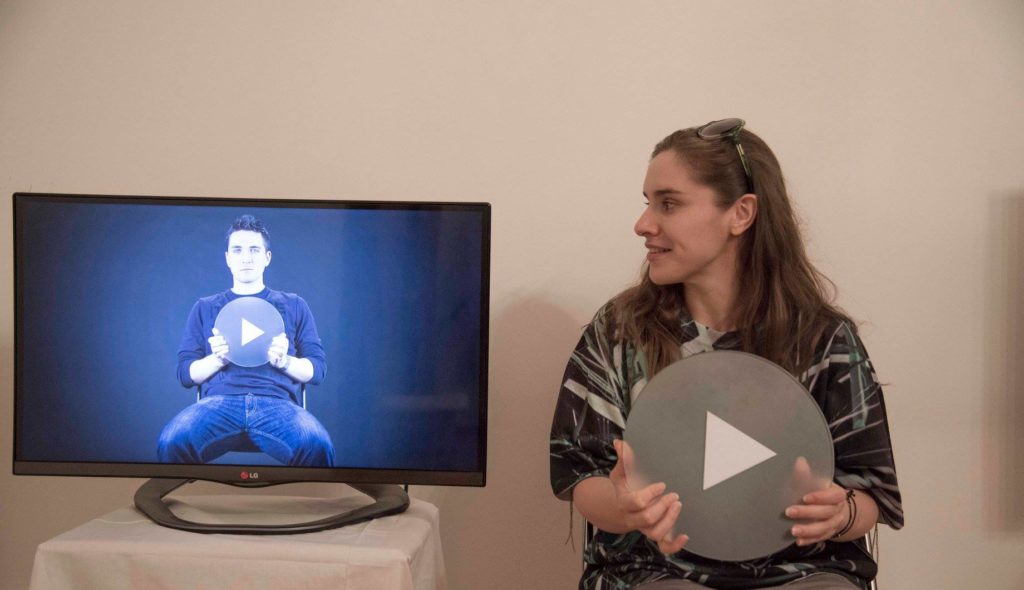Adela Muntean
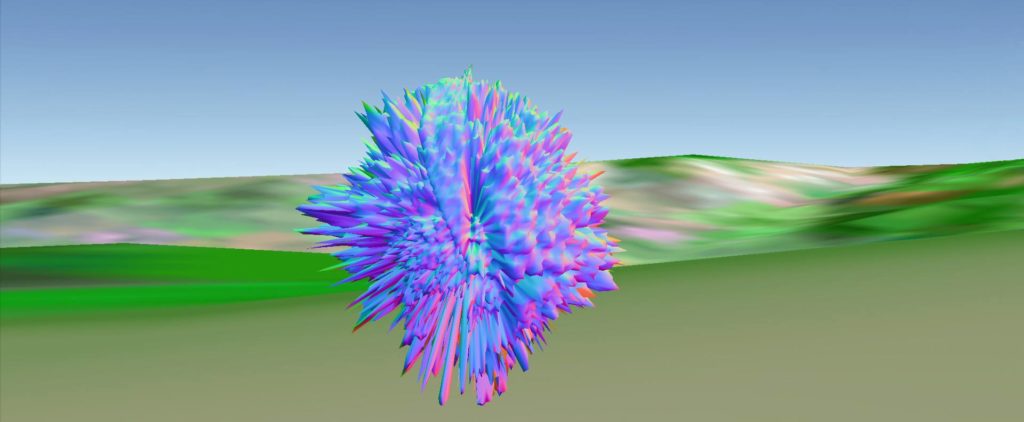
*Part of an Interview Series Taken by Sabin Borş in 2018
Adela Muntean’s works and research explore a multitude of ideas and techniques that the artist developed during her studies in media and cinematography. Her latest interest revolves around the possibility to relate immersive and digital media in the context of interactive documentary and media art. As coordinator and curator, in 2016- 2017 she has implemented and developed a new media department titled The Future is Now at Astra Film Festival in Sibiu, showcasing a series of immersive documentary projects. These projects made use of various technologies and were presented on different platforms, including interactive webdocs, video and virtual reality projects, or fulldome movies. Her ongoing project is devoted to the changing role of the moving image and classical cinema in the digital age.
Sabin Borş: How was it that you started working with digital and the Internet-related content as part of your work?
Adela Muntean: I discovered the Internet during my Bachelor’s Degree. I was studying media and cinematography. I remember the very first project I did involving the Internet: I downloaded a series of quotes, I transformed them in brushes in Photoshop, and then I stamped a series of photos with the messages. The Internet literally set me free and gave me huge independence because I could get the information I needed without depending on anyone. In 2012, I moved to Budapest to pursue my Master’s Degree. Before that, I refused to use Facebook, as all my colleagues were quite Peeping Toms. But in Budapest I was alone and our new class used the Facebook group. I started searching for different things and many international friend requests appeared, mostly by artists. Everything changed all of a sudden because there was this ‘artistic medium of Facebook’. Because I studied film history and cinematography, my first serious project was the cinema and the Internet. The entire theoretical and artistic project can be seen at www.transcinemaexpress.ro.
SB: In this project, you discuss about cinema as multiplied memory and the phenomenology of film, while also approaching a series of side topics such as micro-narratives, visualization, personal histories, the idea of movies as prosthetic memories, or the various archival and (an)archival dimensions of film. Do you see any sort of relation between these ideas and the complexities posed by the Internet as an (artistic) medium? Is there a ‘phenomenological’ or any ‘cinematographic’ dimension to the Internet?
AM: The two dimensions throughout the project are the ‘algorithmic turn’ and the ‘black box in the white cube’ transformations of cinema in relation with the digital. The ‘black box in the white cube’ refers to the Cinema that becomes the object of retrospectives, as the museums and galleries embrace artworks that engage with cinema’s materiality and historicity—personalities, the celluloid, the cinematic devices, and the phenomenology of film viewing in theatrical settings are topics debated through different artworks year after year. While these institutions focus on the physical encounter, the materiality of the cinematic experience remains tangible. On the Internet, the totality of films that constitute cinema has by 2004 become standardly ‘digital intermediaries’ driven by software, manipulated by users and shared on social networks as memory fragments. The ‘algorithmic turn’ refers to the contemporary practices that recycle art cinema classics into new media ‘artefacts’. The process is dependent on the new interstice between software, an algorithmically enabled work process, and the availability of the Internet.
Yes, the ‘cinematographic’ dimension of the Internet is hidden in the concept of ‘cinema of attraction’ that could be transferred to the Internet. While in early cinema, short movies with cats and other funny situations were popular, memes work in a similar manner on the Internet… And many other situations… As a ‘phenomenological’ dimension, probably Machinima and Meta Cinema… All these examples are available and detailed on the mentioned website, in the Digital Archive section.
P O I S O N E D – P A R A D I S E | / DIGITAL DOCUMENTARY, Adela Muntean
SB: We will probably get back to the issue of education and support later, but for now we are curious as to what did you find new and different when moving to Budapest, in terms of schooling and the support given to students working with new/digital media or media in general. Did you find any particular new means or methodologies that you learned how to employ in your projects?
AM: I think that the most important means to to employ in my projects which I learned in Budapest is to stay very critical and have an argument for how I link conceptually the usage of certain software with my artwork. This is really why the title of this program is Media Design… The tailored one-to-one consultation with the guiding professors was, again, crucial in developing our own projects and accomplishing our vision, not just doing general media exercises. The classes are held externally, in different labs or studios where the students have direct contact with the methods applied in real life. Also—we had programs where we worked in interdisciplinary teams along with different museums. The teams comprised a graphic designer, a photographer, a coder, and a media designer. Students who graduate there already have a well-established portfolio at the end of their studies, including an artist website that boosts their online presence.
SB: You mentioned it was important for you that you started using Facebook, mainly in terms of the possibility to network and connect with other people, though you also made reference to it in your project with Bruce Lane to address the issue of (Facebook) surveillance. The complex apparatus of surveillance through social media is certainly one of the dominant issues today in discussing the changing ways in which we use media, so we would like to know how you see the relation between social media, surveillance, and the Internet.
AM: The Dark Side of the web and media generally is in the package… When communication becomes a mass medium, there is always this question. I think no one really knows, we just discover every day what is going on behind and beneath the surface—that we are tracked, that our data is used, that our identity can be cloned, etc.
SB: Do you get all your ideas from the Internet, or do you use it simply to translate ideas from outside the Internet into a digital form?
AM: The specificity of the Internet, the behaviors and methods it involves, are definitely the primary source of inspiration. My interest migrated from street webcams, in general, to intrusive webcams that were recording people’s private surroundings, and then the art webcam pointed to Andy Warhol’s grave; from Google Earth to Google Street View. On Facebook, for example, I used to make a performance with all the newly accepted friend requests, by hitting a loving like on a series of images; on YouTube, I picked the videos where people were eating donuts ‘on the Internet’ to bring an absurd haptic dimension—but, generally, my interest lies in all sorts of technologies, including commercials on outdoor billboards, mobile phones, etc.
SB: There is, of course, this continuous movement, from cinematic reels to moving images and mobile technologies… Is there any particular reason why you found digital content more appealing than other media to express your ideas?
AM: The democratization of technology poses a new set of tendencies and, as a media artist, it feels almost like a mission to create content which generates a reflective space on different topics for the public, to show the dark side or the errors, on the one hand, but also the new creative potential. The digital realm inspires new possibilities of representation and experience: taking photographs and filming in Google Earth, collecting landscapes through webcams, completing a sculpture park with 3D sculptures, montaging opinions from downloaded YouTube videos, or the implementation of tactile interfaces in order to create experiential works.
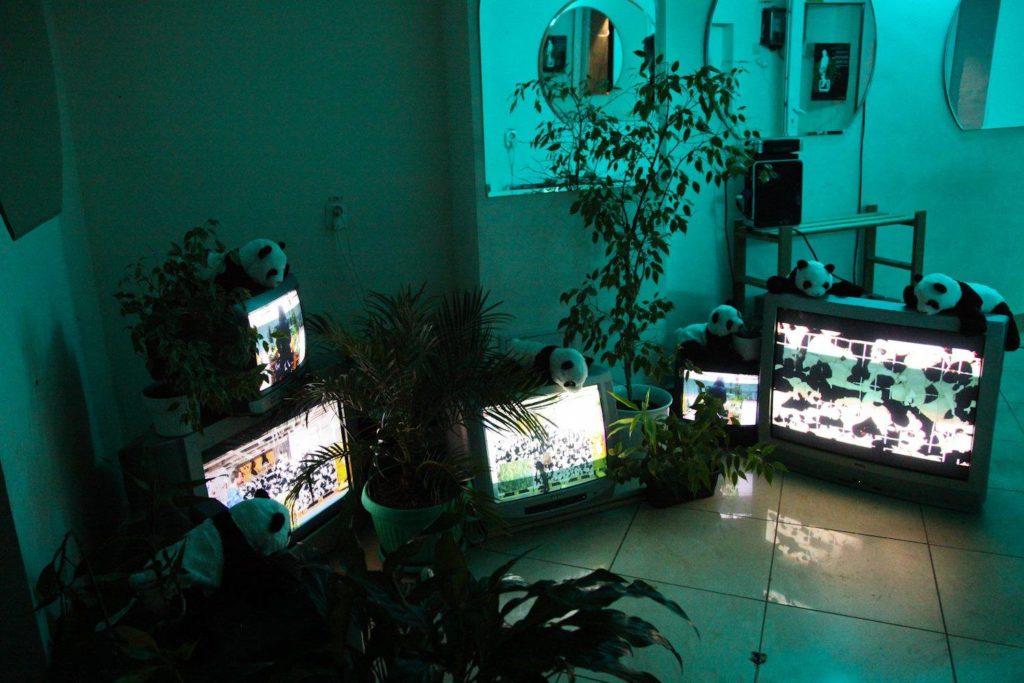
SB: There often seems to be a conflict between the potential brought by the digital realm and this idea of an ‘experiential’ dimension of the works. Not only is experience always a mediated one, but it can often be reduced to the limits posed by a given media support…
AM: Body and technology are intimately related, constantly creating new chimeras. Learning to use new tools gives the body the possibility to extend itself through these external devices, becoming part of us. By using technology, which leads to learning new skills, we integrate it into ourselves, changing the world we live in. Even if we do not reflect on the influence of technology, it still has impact on our lives. This refers to the ‘tacit’ bodily meaning, which affects us regardless of whether we pay attention or not. We can say that’s an art created for the body, which calls on the visitor while reflecting on touch, speech, dance, and running. It struggles to reach some kind of unity—it produces visual, sound, emotions, and tactile sensations. This unity follows the body’s nature: we see, hear, feel, move, and reflect—and these are capacities with the help of which we internalise external devices. Artefacts are a mirror of our changing bodies: contours, shadows, masks, and deformed shapes reveal traces of the body.
SB: Were there any specific influences in the way you developed your projects, in the way you appropriated and made use of media in your work?
AM: A decisive moment was the encounter on the web of a virtual tour which documented an exhibition set at a Romanian museum—MNTR in collaboration with the Institute for the Investigation of Communist Crimes. The 360° space embedded photos, videos, and text altogether with testimonials. I was impressed how this media served as a cocoon preserving a historical moment. Since then, I started researching 360° media spaces and did a similar work in Budapest which presented the archive of the Media Design department. Because of a lack of technology and software, I am still mostly researching immersive media. In 2016-2017, I implemented and developed a new media department entitled The Future is Now at Astra Film Festival in Sibiu, showcasing a series of immersive documentary projects made with various technologies and presented on different platforms: interactive 360° webdocs, 360° video, and virtual reality projects, along with fulldome movies. The works made using Google Earth and Google Street View are translated from a 360° environment into 2D, because of a general lack of proper tools.
SB: Are there any particular aspects or concepts underlining your work? Do you always see your projects developing as a particular form of art from the outset (e.g. a digital art or an Internet art project)?
AM: I am mostly divided between these three roles: artist, researcher, and curator. As a researcher, I take interest in the evolution of media and in finding the various paradigms or state-of-the-art of media art in our time, so media archaeology or media archaeological artworks and research represent a major chapter in my projects. They deal with methods associated with moving image practices merging with new media hybrid arts and the possibilities made available by the Internet: database narratives, webcams, Google Street View, archives, etc. The ‘new’ partakes of the ‘old’ through digital integration and is accessed through digital media and online networks. Old media is re-cycled by means of new media technology—including sensors, software, database, Internet (torrents, social networks, digital archives, etc.)—and is deconstructed by our will to control information. I am interested in the endless media flow generated in real-time that is accessible on our different devices, but also in creating experiences generated by media. My current concerns deal with the reinterpretation of immersive media in the digital age, particularly in the context of interactive documentary and media art: VR, 360° photography and video, or dome projections. One work I have already thought about for some time is to remake and reinterpret Stan VanDerBeek’s Movie-Drome in our contemporary context.
SB: This remake certainly sounds intriguing. Would you focus only on the ideas of a spherical medium or the floating multi-images that replace one-dimensional film projection, or would you continue his vision of encompassing the natural, cosmological and extra-terrestrial dimensions of living, thinking, and intelligence? His ideas and vision certainly reflect the complexities of contemporaneity—and, most surprisingly perhaps, there are still very few artists working with spherical media or the idea of the sphere itself.
AM: I would really like to ‘inherit’ his vision and take it further… to continue his vision and meditate upon today’s and future media systems as he meditated at the time through his experiments. VanDerBeek saw Movie-Drome not as pure cinema, but as a communication tool—an ‘experience machine.’ He envisioned Movie-Drome as the prototype for a communications system, a global network of Movie-Dromes linked to orbiting satellites that would store and transmit images. As networked two-way communication, the Movie-Dromes were meant to ameliorate technology’s alienating impulse. I plan a session of Webjay Surfing exhibition with WJ-S software by Anne Roquigny & Team which allows one to play live with online text, sound, and visuals. I also plan FFF in the dome… FFF— a project by Franck Soudan and Marc Veyrat, is a digital, dynamic, and collective sculpture which makes visible the sSPACE that we occupy in the Facebook eSPACE. I’m currently also planning to read Gloria Sutton’s research on VanDerBeek’s Movie-Drome—in her close reading of the work, she argues that Movie-Drome emphasises multi-sensory experience over the visual.
SB: How do you translate your work from the screen (in)to the physical space? Are your projects intended for screen/the Internet only or do you have a specific format you want to use when exhibiting in physical spaces? How much of the exhibition format is something you conceived yourself and how much does it depend on the space, the curators, or the technical possibilities? Did you ever refuse mounting a work because it did not reflect your ideas of how that work should be exhibited?
AM: In the past, I used the multi-screen exhibiting format but today I am more interested in creating a media landscape rather than just showcasing the work through a window. As everything was always quite experimental, I accepted the compromises due to the lack of technical possibilities. I never exhibited a work in the manner I imagined I would, so I was always happy if there is an opportunity to just show up.

SB: How exactly do you understand this idea of a media landscape?
AM: It could be The Internet of Things… where works don’t necessarily need to be visual, but still have an important triggering role. Media becoming invisible, hidden… but sensing, and exchanging our data, connecting and constantly communicating…
SB: Which of your artworks do you think is more representative of your work?
AM: The reinterpretation of the above mentioned Movie-Drome, showcasing today’s media which ‘does not have any fixed finite boundaries’, is representative through the mode of exhibiting and my current concern with creating media experiences.
SB: What role does software and hardware play in your work and how important is technology as such in developing your work? Do you work with code as well?
AM: Technology, software, and hardware are the main components of my works, however, the lack of it always pushed me into creating a sort of video which ‘plays’ the artwork. The other solution I went on was collaborating with other artists who did the 3D elements or parts of the code. In festivals, I usually transfer the project on someone else’s laptop to screen it or perform it.
28 SECONDES | PIXEL PUZZLE MOSAIC, Adela Muntean
SB: This idea of ‘playing the artwork’ is yet interesting, albeit non-intentionally—it reflects an improvised way of presenting the work, of course, but it also involves a certain irony that may at times be specific to media itself, don’t you think?
AM: There is always the backstage events and the scene, the exhibition space… In its development, all media has irony integrated in the process. One designs something but the system is not perfect so media does something else… I type a word and the phone re-writes my words and so on…
SB: We were discussing at the beginning of the interview about your experience as a student in Budapest… How much is ‘digital art’ in general encouraged in art schools in Romania, in your opinion?
AM: A center called CINETic was opened in Bucharest and Interactive Digital Arts in Cluj Napoca, focusing on new media technologies. They started organizing workshops and that is good news! However, the lack of classes in digital art lowers the chances to educate the new generations to see today’s technologies in a critical way and find suitable solutions for its infrastructure—it transforms them more and more in users rather than creators.
SB: Did you find any support from art galleries, institutions, or private collectors in realizing your works?
AM: In Romania, the support came from the Media Art Festival in Arad. They helped with the exhibition. However, there is no institution in Romania to support the actual production. I think it’s easier to find support internationally, but it would certainly help if there would be any constant or yearly programs in Romania to support creation.
SB: The galleries and institutions here do not understand the specificities of working with digital content…
AM: I think galleries and institutions in Romania are embracing the digital and making efforts to organize specific events.
SB: So it is safe to say you mostly found opportunities to showcase your work outside Romania.
AM: My projects were merely validated and exhibited internationally rather than in Romania. It was easier when I was a student to be dedicated to creating artworks. Now I think more and create less. I am more critical and choose better the places where I exhibit—I think this will be a lifelong project. In Romania, if someone uses a Kinect to convey some body shadows, there’s a big wow around it. The spectators are impressed, for them everything is so new. There is still a lack of digital culture in general. Slowly things will fit I hope…
SB: Do you think digital visual culture has changed over the past few years in any significant way? Are people still interested in the Internet and its iconography in the same way they were interested three or ten years ago, or do you see things changing in our relation to digital media and the Internet?
AM: The development of technologies has democratized a big part of digital art culture. The aesthetics and modes of production have become in many ways similar, the language is somehow unified. It’s not enough anymore to deliberately create some glitch effect and say ‘This is digital art’. Of course, the good part is that the new generation adopts these ‘ready-made’ effects and more people become interested in the subject. I see people joining the communities they are interested in, even though there is a division between users and creators or connoisseurs. The Internet and digital media are growing very tight at an individual level: everyone is grooming their social media accounts and avatars. I think it’s the perfect time to adopt digital media in schools by creating meaning, by working with it and not letting it dominate us in an uncontrollable way.
Adela Muntean (b. 1988) is specialized in film / TV directing and media design. As a digital artist she works on topics such as monetization of human value and the symbol of money in social discourse, memory and environmental topics. As a PhD researcher her current concerns deal with the diverse artistic practices in domes and planetariums in the digital age. As a curator and artistic director she is currently developing a cultural program which aims to connect the Romanian planetariums to the international industry of immersive art.
Sabin Borș (b. 1981) is an independent editor and curator who also works as freelance layout designer for various web and print cultural projects. He is the founder and editor of the anti-utopias.com contemporary art platform and has been working for various specialised print and online media outlets in the field of art and architecture since 2009. In parallel with his Ph.D. thesis in philosophy—tackling the subject of archives, discourse, and contemporaneity—he started developing a multi-modal archival installation. The installation is intended as a critical approach to constructing cross-cultural and cross-disciplinary frameworks for the documentation, interpretation, and dissemination of contemporary art, providing alternative understandings of the socio-political foundations of art, constituent cultural differences and transitions, or superposed cultural, scientific, and technological interactions. He takes particular interest in dialogical constructions that create divergent networks of meaning between mediums, disciplines, and practices.
